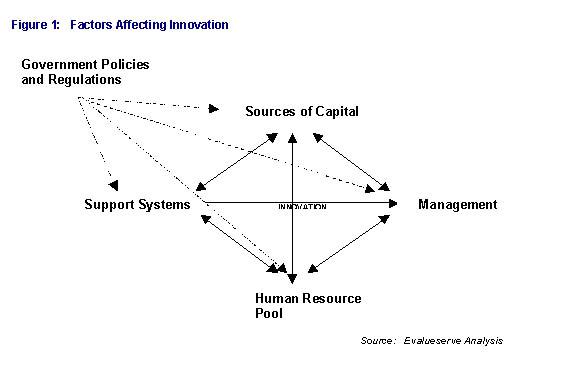by Evalueserve
A special Summit for the Future Report
by B Vijayalakshmi, Hedda Pahlson-Moller, Evalueserve
April 10, 2006
Innovation: The DNA for Growth
You can’t solve a problem on the same level that it was created. You have to rise above it to the next level – Albert Einstein
This quote by Albert Einstein clarifies the common misconception about innovation. Innovation is not only about developing a product or service from scratch but is also about adding value to an existing product or service. Organisations across the world have focussed on innovation in order to achieve the competitive advantage required for creating and sustaining growth. The effect of globalisation on the world economy has also played a significant role in fostering innovation. Organisations soon realised that without innovation they faced the possibility of extinction.
Research and development (R&D) and innovation go hand in hand; however, R&D is only one aspect of innovation. While innovation is about introducing a new idea or process to the end customer or developing and improving an existing product or service, R&D is about conducting original investigations to gain new knowledge for improving products or services.
Risks and Rewards come in a package
Innovations and the risks associated with them are directly proportional. On the other hand, the rewards of taking these risks are high. All resources employed for successful innovation are subject to some form of risk. These resources vary from the capital employed to the use of raw material, time, manpower and technical skills.
A successful innovation is subject to various external and internal factors. (Figure 1)

These factors include government regulations and support, availability of skilled labour, the firm’s internal management and its sources of capital. India and China attract large investments in R&D due to the availability of highly skilled manpower. The UK has an average innovation performance as its firms are less inclined to change. Therefore, they lag behind other geographies such as the US in adopting new and innovative business practices.
Collaborations such as that of Tata Consultancy Services in India with Stanford University for research in data privacy are examples of pooling existing expertise. Government involvement is a key factor as it influences all other factors. A government’s fiscal measures and macroeconomic policies promote access to capital. It has a role in developing science and technology centres, and associations. It also has a role in encouraging R&D in institutes that provide the support system required for innovation and R&D. The government is also responsible for providing funds for quality education and sourcing the required human capital. This can be seen in the United States where the government has increased the number of H1B visas in order to increase the skilled labour pool for its IT sector.
Extent of Risk in Different Stages of Innovation
There are four stages in a product’s or service’s life cycle. Innovation can take place at any of these stages as can be seen in Figure 2.

However, innovation or the introduction of a new product or service in a new market will always involve a considerable amount of risk. These risks will vary, depending on the stage of the life cycle in which the innovation is implemented.
Innovations can be classified into four distinct types. Breakthrough innovation, which is the first type, involves the generation of a complete new range of services or products for a new market or user. Breakthrough innovation is always implemented in the introduction stage of a product life cycle. In this type of innovation, a firm will succeed in attracting the right financiers and customers only if it invests adequate time and resources for the same. However, when an innovation is introduced, it can have two consequences: it may face outright rejection or it may be well received and go on to be a resounding success. Yet, there is no way of estimating the time that an innovation will take to ultimately become a success.
The second and third stages in the life cycle of a product or service are growth and maturity, respectively. If a firm decides to innovate in the growth and maturity stages, it can do so either by introducing the product or service to a new user or market (geographic innovation) or by introducing a substitute product to an existing market (substitute innovation). Geographic innovation helps to increase the market share for a firm while substitute innovation helps to increase its product line. Both types of innovations are less risky as compared to breakthrough innovation. This is so because by then the firm would have developed a greater understanding about its innovation. It would not only have awareness about the product’s success, but would also be aware of market needs.
The decline stage marks the final phase of a product’s or service’s life cycle. In this stage, an organisation usually faces a financial crisis, and its product or service may be on its way out from the market. An incremental innovation, which is the fourth type of innovation, can be most appropriately implemented at this stage. Incremental innovations refine existing ideas, products or services by adding certain features or characteristics. Yet, it involves some amount of risk because an innovation is at all times a risky proposition. Therefore, by implementing innovation in the decline stage, the organisation is taking a calculated risk. The innovation may earn a temporary reprieve for the product, or the money expended on the innovation may not fetch any returns.
Incremental innovation can occur in both the maturity and decline stages of a product’s or service’s life cycle. Most organisations opt for incremental innovation in three circumstances – to tackle increasing market competition, to change product features as per a felt need or to boost revenues.
About
Evalueserve
Evalueserve is a global knowledge services firm that provides high value-added research services to leading edge clients worldwide. Our clients include global consulting and market research firms, investment banks, Fortune 500 corporations, as well as SMEs in financial services, telecom and technology, pharmaceuticals and biotech, and various other sectors such as automotive, oil and gas, FMCG, Retail, etc. Evalueserve’s client executives are located in the North and South America, Europe, Asia-Pacific and the Middle East. The client executives are supported by its multi-lingual research team of 750 professionals, based in Gurgaon India. Contact: Hedda Pahlson-Moller, hedda.pm@evalueserve.com
www.evalueserve.com
Club of Amsterdam
The Club of Amsterdam is an independent, international, future-oriented think tank involved in channelling preferred futures. It involves those who dare to think out of the box and those who don’t just talk about the future but actively participate in shaping outcomes.
We organize events, seminars and summits on relevant issues and publish findings & proceedings through various off-line and online media channels. Our goal is to become a global player and catalyst for innovation in industries, science and society.
The Club of Amsterdam is a not-for-profit foundation registered in The Netherlands.
www.clubofamsterdam.com
Download the full report as a *.pdf: click here



